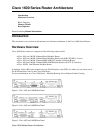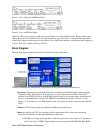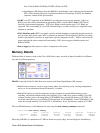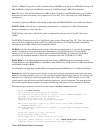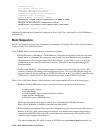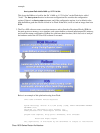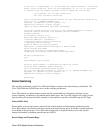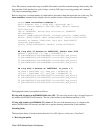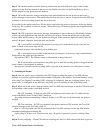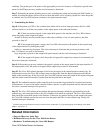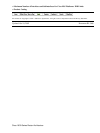Bridging software.
X.25 software, Version 3.0.0.
Basic Rate ISDN software, Version 1.1.
1 Ethernet/IEEE 802.3 interface(s)
1 Serial(sync/async) network interface(s)
1 ISDN Basic Rate interface(s)
System/IO memory with parity disabled
2048K bytes of DRAM onboard 16384K bytes of DRAM on SIMM
System running from FLASH
7K bytes of non−volatile configuration memory.
12288K bytes of processor board PCMCIA flash (Read ONLY)
Configuration register is 0x2102
Additional information can be found in Comparison of Cisco 1601−Cisco 1604 and Cisco 1605−R Memory
Architectures.
Boot Sequence
Not all Cisco products have the same components or mechanisms for booting. This section describes the boot
sequence in the Cisco 1600 Series Router.
The boot ROM which is read−only memory contains two programs:
The ROM monitor or ROMmon − The ROMmon is a diagnostic image that provides the user with a
limited subset of commands. This diagnostic mode is most often used during recovery procedures
(forgotten password or wrong/corrupted Cisco IOS software). It is possible to view or modify the
configuration register from this mode and to perform a Cisco IOS software upgrade through the
Xmodem transfer.
•
The Bootstrap (RxBoot) − The bootstrap program is written to find and load a copy of Cisco IOS
software according to the settings of the configuration register. The Cisco IOS software image can
be located either on the system Flash, on a PCMCIA Flash card, or on a Trivail File Transfer Protocol
(TFTP) server. Usually, the Cisco IOS software image resides on the PCMCIA Flash card.
•
When a Cisco 1600 Series Router is first powered up, the bootup sequence involves the following steps:
ROMmon (in Boot ROM) takes control of the Main Processor and performs the following:1.
control register settings♦
console settings♦
initial diagnostic tests of memory and other hardware♦
data structure initialization♦
Flash file system (MONLIB) setup.♦
Based upon the configuration register value in Non−Volatile RAM (NVRAM), the router
either stays in ROMmon, or RxBoot is executed from Boot ROM.
RxBoot analyzes the hardware. Based upon the configuration register value, the router either stays in
RxBoot, or the Cisco IOS software image file (default or as defined in the startup configuration) is
executed from PCMCIA Flash or RAM (or moved there from the network). This main Cisco IOS
software image re−analyzes the hardware.
2.
The router configuration file, which is stored in NVRAM, can contain boot system commands. For
Cisco 1600 Series Router Architecture





